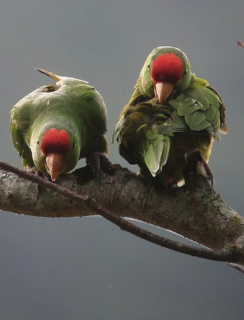Red-fronted Conure |
|
|
Also known as: Red-fronted Parakeet, Scarlet-fronted Parakeet, Wagler's Conure or Parakeet
Photos
View in GalleryDid You Know?
The Red-fronted Conure has been heavily traded: since 1981, 76,974 wild-caught birds have been reported in international trade (2005).Academic Research
Related publications: Psittacara wagleriSpecies Profile
Genus: Psittacara | Species: wagleri
Size:
36cm (14 in)
Weight:
180-260g (6.3-9.1 oz)
Subspecies including nominate:
two: P.w. wagleri, P.w. transilis
Colour Adult:
P.w. wagleri: Both adults mainly green, with yellowish underparts; red forehead to forecrown; occasional red band or scattered red feathers on throat; green bend of wing and carpal edge; olive/yellow greater underwing coverts and undersides of flight feathers. Bill horn in colour. Eye ring dark. Eye dull yellow with grey inner ring.
P.w. transilis: Both adults as in wagleri but in general darker green in colour; red on crown darker and less extensive.
Colour Juvenile:
P.w. wagleri: Red on forecrown duller and less extensive or missing. Bill pink/grey at base of upper mandible. Eye ring bare and grey/white. Eye grey.
Call:
Calls made in flight are repetitious and high-pitched, discordant notes; higher in pitch than that of Mitred Conure A. mitrata.
Listen NowVideo Links:
Video 1 | Video 2More Information:
Content Sources:
CITES
BirdLife International
Cornell Lab of Ornithology/Birds of the World
Parrots: A Guide to Parrots of the World, Juniper and Parr, 1998
Parrots of the World, Forshaw, 2006. 2010 edition
Parrots in Aviculture, Low, 1992.
Psittacine Aviculture, Schubot, Clubb and Clubb, 1992.
Photos
View in GalleryDid You Know?
The Red-fronted Conure has been heavily traded: since 1981, 76,974 wild-caught birds have been reported in international trade (2005).Academic Research
Related publications: Psittacara wagleriSpecies Care
Captive Status:
Rare
Longevity:
Not recorded.
Housing:
Aviary or suspended enclosure, minimum length 3m (10 ft).
Diet:
Fruits such as: apple, pear, kiwi, papaya, mango, cactus fruits, banana, orange, forming about 30 percent of diet; vegetables such as: carrots, celery, green beans and peas in the pod; green leaves such as: Swiss chard, lettuce, sowthistle, dandelion, kale, chickweed; fresh corn; small seed mix such as: canary, millet and smaller amounts of oats, buckwheat, safflower and a little hemp; small amount of sunflower seed, soaked or sprouted; cooked beans and pulses and boiled maize and complete kibble.
Enrichment:
Provide bird-safe, unsprayed branches of fir, willow, pine or saskatoon bush; vegetable tanned leather or wooden block chew toys; push and pull toys; foraging/puzzle toys; swings, ladders and ropes. Provide overhead misters or shallow water bowls for bathing.
Nest Box Size:
Vertical box 12" x 12" x 18" (30.5cm x 30.5cm x 45.7cm).
Clutch Size:
3-4
Incubation Time:
23 days
Fledging Age:
8-9 weeks
Hatch Weight:
10g (0.35 oz) (A.w. frontatus)
Peak Weight:
Not recorded.
Weaning Weight:
Not recorded.
Photos
View in GalleryDid You Know?
The Red-fronted Conure has been heavily traded: since 1981, 76,974 wild-caught birds have been reported in international trade (2005).Academic Research
Related publications: Psittacara wagleriSpecies Wild Status
World Population:
Unknown, decreasing.
IUCN Red List Status:
Near Threatened
CITES Listing:
Appendix II
Threat Summary:
This species has experienced some decline due to habitat loss and heavy trapping for the wild bird trade.
Range:
P. wagleri: NW Venezuela, from Sierra de Perija, Zulia and both slopes of Andes in Merida east to mountains of Yaracuy and Distrito Federal, and W Colombia, from Santa Marta Mountains and Sierra de Perija south along Andean cordilleras; also reported on eastern slope of Cordillera Oriental, to Narino.
P. transilis: Coastal mountains of Sucre and N Monagas, NE Venezuela.
Habitat:
Found from 350-2800m (1148-9184 ft) in moist and humid forest including cloud forest and secondary growth mainly in upper tropical and lower subtropical zones, with occasional forays into the subtemperate zone. In Peru this species has been reported from semi-arid cloud forest. May also be found in humid plantations, cornfields and cactus scrub.
Wild Diet:
Diet includes a variety of fruits, nuts and seeds; may take grain or fruit crops.
Ecology and Behaviour:
Seen in social groups of up to 20; occasionally 300 or more. Feeds in the canopy and roosts at dusk in communal roosting areas in cliffs, which are also required for nesting.
Clutch and Egg Size:
3-4 eggs (captive)
Breeding Season:
December-June, N Colombia; April-June, Venezuela. Nest is in cliff crevice, often colonially.
Related Links:
Photos
View in GalleryDid You Know?
The Red-fronted Conure has been heavily traded: since 1981, 76,974 wild-caught birds have been reported in international trade (2005).Academic Research
Related publications: Psittacara wagleriMembers Only Resources
Please log-in now to find more research, resources and tools.
Not a Member?
Find more great information:
Gain exclusive access to 600+ pages of additional research, seminars and podcasts, specialists to ask your toughest questions, and dozens of other fun resources - when you become a WPT member.
Join Today >>

































